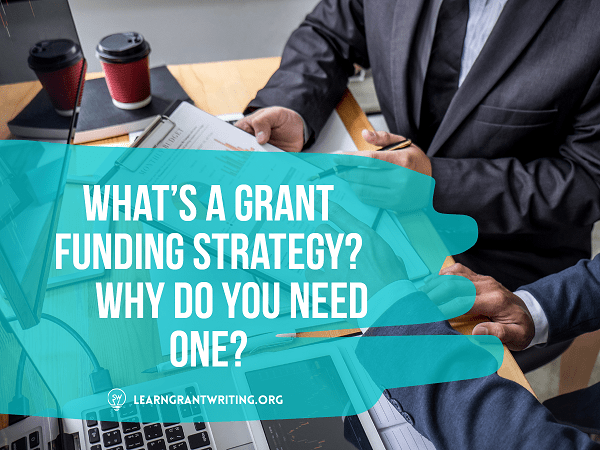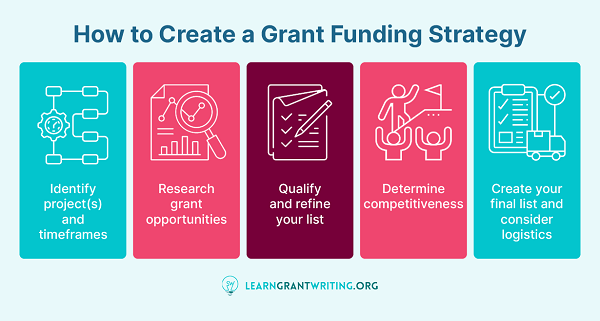
Grantwriting plays a crucial role in the nonprofit ecosystem, helping organizations raise more support and build productive relationships with partners in the sector. But, as anyone who’s applied for grants knows, it can be challenging.
Grantseeking can feel like a never-ending quest. If you bounce from opportunity to opportunity, you lose momentum each time you sit down to write a new proposal. This lack of a coherent strategy can overwhelm any grant team, sapping energy and enthusiasm over time.
However, whether you work at a nonprofit and are writing a grant for the first time or freelance as a grantwriter for organizations in your community, there’s one step you can take that will make a world of difference for your grantseeking efforts—creating a coherent Funding Strategy.
What’s a Funding Strategy?
A Funding Strategy is a long-term roadmap of your grantseeking plans.
This concept is a key component of our curriculum at Learn Grant Writing, and we’ve seen it fuel sustained success for nonprofits and grantwriting freelancers alike.
By identifying well-aligned grant opportunities and charting out their deadlines, you can create a strategic framework for your efforts, ultimately saving time and effort when it’s time to move on to the next proposal.
Our recommendation is to create a 12 to 18-month Funding Strategy consisting of the top two to five grant opportunities you’ve identified as good fits for your organization and planned projects.
What Are the Benefits of Creating a Funding Strategy?
Investing the time in researching grant opportunities and prioritizing your options brings several tactical benefits:
- It produces a concrete roadmap. Even if you adapt your strategy over time based on new priorities and opportunities that arise, having a clear reference point can greatly reduce the shot-in-the-dark feeling that plagues so many grantseeking teams.
- It helps you take a more intentional approach. With a clear vision and big-picture objective, it’s easier to stay focused, work your way through the roadmap piece by piece, and keep the entire grant lifecycle in mind.
- It reduces last-minute chaos. Have you ever been faced with a last-minute grant deadline or needed to dramatically shift course when project plans change? A Funding Strategy reduces these risks and helps the whole organization buy into a holistic plan.
For freelance grantwriters, Funding Strategies bring an added benefit—they’re a perfect foot-in-the-door tactic. By proposing an extended plan to a client, you’ll excite the nonprofit with the prospect of consistent funding and make a strong case for hiring you to execute the entire strategy.
How Do You Create a Funding Strategy?
If you’re ready to develop a Funding Strategy for your organization, how do you get started? We recommend these core steps:

- Identify project(s) and timeframes. Begin by determining what you intend to fund with grant support over a specific timeframe.
- In many cases, you may have a single large project or new program planned that will require ongoing funding. Other nonprofits may have several smaller initiatives on the docket and would benefit from a holistic plan for funding them.
- A 12 to 18-month timeframe is a typical sweet spot. This will prevent you from both needing to create a fresh strategy too soon and locking into a longer-term plan that reduces your flexibility.
- Keep in mind that your projects should inform the grant opportunities you seek, not the other way around. Avoid planning new projects solely to receive grants for them, and instead lead with a clear future vision.
- Research grant opportunities. Start identifying opportunities that align with your project(s) and timeframe.
- For federal grants, the Grants.gov listing directory is a central resource. Use state- and municipality-specific resources for more local government funding opportunities.
- For foundation grants, there are numerous options to consider. Platforms like GrantStation compile tons of opportunities from foundations and governments in one easy-to-use place.
- Follow your typical grant research process to identify grants that align with your project, mission, timeframe, region, target population, and additional criteria.
- Qualify and refine your list. Narrow down your initial list to those worth further evaluation.
- Consider the relevance and value of each opportunity. Use a standardized process, like a concrete decision matrix, to rank each opportunity, and perhaps ask a teammate to conduct their own screening so you can compare results.
- We recommend trimming your list down to the top 20-25 grant opportunities at this stage.
- Determine each grant’s competitiveness. Add another factor to your decision-making process to generate a final ranked list.
- Consider your likelihood of success for each of the remaining top grant opportunities. How well-known is the funder? How closely do your mission and proposed project align with its stated priorities and past funded projects?
- Contact the funders to ask questions if needed. Direct answers will be much more valuable for this process than hunches and will help your Funding Strategy drive the maximum possible impact.
- Create your final list and consider logistics. Time to develop the final deliverable: your Funding Strategy.
- Using everything you’ve learned, determine the top two to five grant opportunities that are worth your time to pursue and give you the highest chance of success.
- Take a look at their proposal due dates and overlay them on your project’s preliminary timeline. Lay out a rough calendar that will keep you on track to apply for each grant on time.
Does developing a Funding Strategy sound like a smart investment of your time? If so, here are the first steps you can take today to get started:
- Brush up on your grantwriting skills, especially if you’re new to grantwriting or feel a little rusty.
- Discuss the benefits of a Funding Strategy with leadership and secure buy-in to start developing one.
- If you don’t yet have one, lay out a timeline or calendar for the key projects your organization wants to complete within the next year to use as the basis for your plan.
- Sign up for this upcoming webinar on April 30, Craft a Winning Grant Strategy for 2024-25, to get a step-by-step process to help you develop your grantseeking strategy.